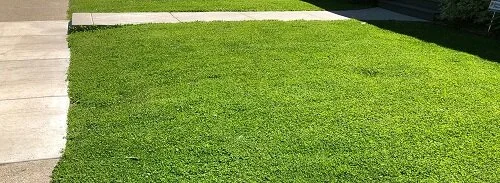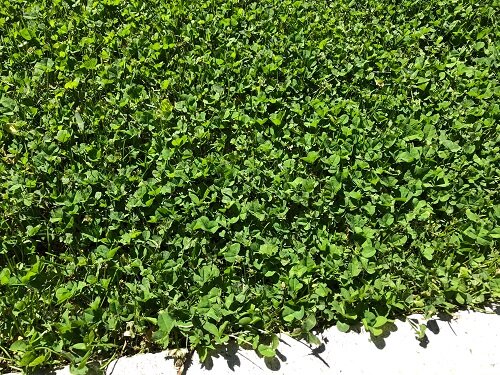Tips For Growing Clover Lawns
A clover lawn with no mowing, no maintenance? Sounds great!?
We all make assumptions about the benefits of a clover lawn, both good and bad.
Clover was once an important part of every lawn, and clover seed was included in most lawn seed mixes, and they coexisted wonderfully.
But eventually, as we homeowners were encouraged by chemical companies to eradicate broadleaf weeds in our lawns, the clover was caught in the crossfire and was also killed. So that would be the first and most important thing to be aware of.
Although most people choose clover specifically, so they do NOT have to kill weeds and maintain grass.
There are many many benefits to a clover lawn, but it is not totally maintenance-free.
Whether a clover lawn is for you depends on what you expect of it and your motivation to convert. Environmentally clover wins the contest, but you need to weigh the pros and cons for your situation.
Benefits of a Clover Lawn
Clover is drought tolerant and requires much less water than grass
Clover does not require fertilizer
Pure clover lawns require very little mowing
Clover easily adapts to most growing conditions
Clover fixes nitrogen from the air and releases it to the soil for other plants to use.
Clover stays green for a longer season than grass.
Pollinators love clover in bloom
Clover stands up to pet burns better than grass
Clover is very persistent with an aggressive root structure, choking out most weeds.
Clover discourages many lawn pests
Drawbacks Of A Clover Lawn
Most clover does not hold up well to heavy foot traffic, but will do better with a clover/grass mix for play areas and frequently walked areas.
Clover will spread into your gardens and into neighboring lawns, which may not be appreciated by your neighbor
Clover lawns perform best in clay or sandy loam with a neutral pH
Clover lawns do need to be mowed if grown with traditional lawn grass, and timing of mowing is important. If you prefer to control blooming and grass height mowing may be necessary as much as weekly.
Herbicide cannot be used for broadleaf weeds should they appear
Clover is a short lived perennial and will need to be over seeded every couple of years for a clover only lawn
Grass stains usually are not from grass, they are from clover.
Local deer will love feasting on your clover
How To Get Started
To get started with a clover lawn, a standard seed mix should contain about 20 percent clover seed with the remaining 80 percent the best drought tolerant seed for your region.
But many new micro clovers can be seeded up to 100 percent clover in ideal growing conditions.
Selecting the Best Clover Seed for Your Region
Be sure to fully evaluate the best clovers for your region, especially in the North and Midwest, where all clovers will not tolerate winter conditions.
If you already have substantial patches of clover in your lawn, you may be able to simply encourage their spread. These indigenous clovers are typically ideal for your conditions.
Seeding and Establishing a Clover Lawn
Clover seed should be sown after the last spring frost and be kept moist with daily watering if necessary for a couple of weeks.
Clover can be seeded into an existing lawn in spring before the grass takes hold of the nutrients the clover will need to establish.
To establish a new lawn, the clover seed should be sown alone to obtain a proper cover rate, then sow grass seed separately.
Maintenance of a Clover Lawn
Routing maintenance of a clover lawn is minimal. The clover should be allowed to bloom (usually not until the second season) and go to seed before the first mowing.
Then it can be cut as short as 2” to remove the spent blooms. Thereafter the lawn can be cut at about 3”.
You may still need to mow as much as weekly if you prefer to control blooming and the height of grasses.
Different Clover Varieties for Different Conditions
Each clover performs a little different, so be sure you understand the varieties for your area before you get started.
Some clovers do get as much as 8 inches tall, so you might be mowing more than you think or just allowing the lawn to be a bit longer than usual.
Dutch White Clover and New Zealand White Clover tend to remain short.
Micro clovers require a bit more sun than white clovers, more than six hours ideally. Micro clovers are small-leaved dwarf varieties of white clover, and so are lower growing, staying under 6 inches even if you never mow it.
Occasional mowing will “stunt” it and keep it shorter and with even smaller leaves and no blooms. But even left un-mowed, they will not spread as aggressively or flower as much, therefore, seedless. Micro clover is best combined with a traditional grass lawn.
Points to be Aware of for Clover Lawns
Other points to be aware of:
Although clover is drought tolerant it will not tolerate consistently dry conditions
Although white clover is shade tolerant, it will not grow in shade
Although clover is adaptable, it will not tolerate consistently wet conditions or standing water
Many people are curious about clover lawns, so I have taken photos of a striking emerald green carpet that caught my attention in the neighborhood.
Yes, I WAS surprised to look closely and see clover!
Emerald Carpet of Clover
Clover Lawn in Bloom
Mowing Spent Blooms
Densely Growing Clover
Minimal Traditional Grass in Clover Lawn
This lawn is gorgeous, but it is also meticulously maintained. That is still minimal work compared to a traditional grass lawn.
Are you ready for a clover lawn?





